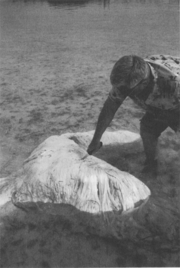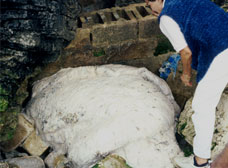
Bermuda Blob
Encyclopedia

Globster
A globster, or blob, is an unidentified organic mass that washes up on the shoreline of an ocean or other body of water. The term was coined by Ivan T. Sanderson in 1962 to describe the Tasmanian carcass of 1960, which was said to have "no visible eyes, no defined head, and no apparent bone...
s that washed ashore on Bermuda
Bermuda
Bermuda is a British overseas territory in the North Atlantic Ocean. Located off the east coast of the United States, its nearest landmass is Cape Hatteras, North Carolina, about to the west-northwest. It is about south of Halifax, Nova Scotia, Canada, and northeast of Miami, Florida...
in 1988 and 1997. At first thought to be the remains of a cryptid
Cryptid
In cryptozoology and sometimes in cryptobotany, a cryptid is a creature or plant whose existence has been suggested but is unrecognized by scientific consensus and often regarded as highly unlikely. Famous examples include the Yeti in the Himalayas and the Loch Ness Monster in...
, analysis suggests that the blobs were the remains of known sea creatures.
There has been some confusion in the past as to whether there were three Bermuda blobs or only two. Cryptozoologist Michael Newton has revealed, however, that there were only two — one washed ashore in 1988 (and later dubbed Bermuda Blob 1) and one washed ashore in 1997 (Bermuda Blob 2). Internet claims that a Bermuda blob was also washed ashore in 1995 were thoroughly investigated by Newton, who discovered that there was no record whatsoever of any such occurrence present in any of the local newspapers held at the Bermuda National Library
Bermuda National Library
The Bermuda National Library is the national library in Bermuda and it is located in Hamilton....
or in the archives of the Bermuda Aquarium, Museum, and Zoo, and that in fact such claims were due entirely to a misprint in a 2004 paper by blob researchers Pierce et al.. Quoting Newton: "While citing their earlier study repeatedly, the authors [Pierce et al., 2004] claimed that "Bermuda Blob 1 . . . washed onto Bermuda in 1995,” rather than 1988 — an error that apparently deceived both Wikipedia’s anonymous contributor and all who followed after."

1988
The first Bermuda Blob was found by Teddy Tucker, a fisherman and treasure hunter, in Mangrove Bay in May 1988. Tucker described the blob as "2½ to 3 feet thick . . . very white and fibrous . . . with five 'arms or legs,' rather like a disfigured star." Samples of the specimen were analysed in 1995 and it was suggested that these were from a poikilothermPoikilotherm
A poikilotherm is an organism whose internal temperature varies considerably. It is the opposite of a homeotherm, an organism which maintains thermal homeostasis. Usually the variation is a consequence of variation in the ambient environmental temperature...
ic sea creature, either a large teleost (bony fish) or an elasmobranch (shark or ray). Subsequent reanalysis of this specimen by the same team, however, using advanced genetic techniques not previously available, confirmed that it was actually the remains of a whale
Whale
Whale is the common name for various marine mammals of the order Cetacea. The term whale sometimes refers to all cetaceans, but more often it excludes dolphins and porpoises, which belong to suborder Odontoceti . This suborder also includes the sperm whale, killer whale, pilot whale, and beluga...
.
1997

Adipose tissue
In histology, adipose tissue or body fat or fat depot or just fat is loose connective tissue composed of adipocytes. It is technically composed of roughly only 80% fat; fat in its solitary state exists in the liver and muscles. Adipose tissue is derived from lipoblasts...
from a whale.

